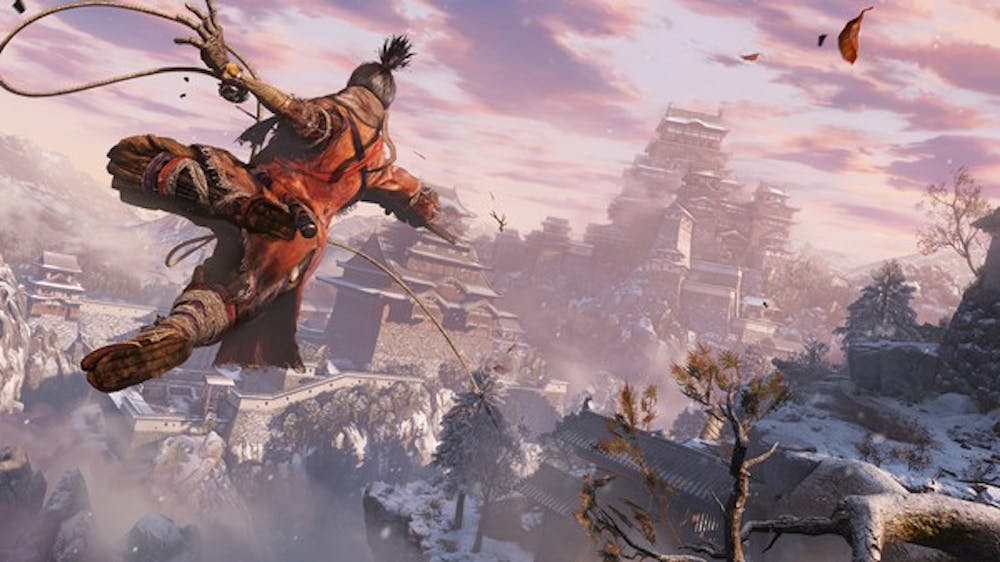The developers at FromSoftware have made a name for themselves by creating the Soulsborne games. Consisting of the Dark Souls trilogy and Bloodborne, these games are notorious for their difficult gameplay. While this has turned off a lot of gamers, it also garnered a loyal fanbase. With the release of the last Dark Souls game back in 2016, fans of FromSoftware eagerly awaited what game the company would release next. With that game now finally released, Sekiro: Shadows Die Twice proves to be another success for FromSoftware.
Similar, yet different from what has come before
Taking place in a fantasy version of Japan’s Sengoku period, the game follows Wolf, a highly skilled shinobi and bodyguard to a young lord named Kuro, the Divine Heir. As they travel through the lands of the Ashina clan, they are attacked by a mysterious samurai who kidnaps Kuro. Wolf battles the samurai but is defeated, losing his left arm in combat. However, Wolf is saved from death by a mysterious sculptor, who takes him to an abandoned temple and outfits him with a special prosthetic arm. Now rechristened as Sekiro (meaning one-armed wolf), the shinobi battles the Ashina to rescue his liege lord at any cost.

Image from Steam
Fans of FromSoftware’s previous games will notice that Sekiropossesses similar elements to the Dark Souls games. Sculptor Idols in the game function similarly to Dark Souls’ Bonfires, serving as checkpoints that the player can either travel from or upgrade their skills and stats at. The Health Gourd is this game’s equivalent to the Estus Flask, as both are a healing item with a limited number of uses. These familiarities serve as a welcome to veterans of the Soulsborne games, as it eases them into the game before showing them just how different things really are.
While it contains similar elements, Sekiro is a completely different beast from the Soulsborne games. Taking inspiration from the Tenchu games, it features a stealth element, where Sekiro must sneak around the environment undetected and eliminate enemies one by one. Combat is also completely different from the Soulsborne games. The combat is mainly focused on swordplay, with Sekiro’s main weapon being a katana. Rather than whittling away at an enemy’s health, the combat has an emphasis on destroying their posture and poise. This is mainly done through blocking and deflecting enemy attacks. Once the enemy’s posture has been broken, Sekiro can perform the Shinobi Deathblow. Similar to Bloodborne’s Visceral Attacks, it swiftly and brutally kills the enemy with one quick blow. The focus on posture damage makes the gameplay tense and exciting, as the player has to alternate between attacking and perfectly timing their blocks and deflects.
However, the real treat of the game is Sekiro’s prosthetic arm. Its main feature is the built-in grappling hook, which allows the player a quick way to explore and traverse the game world, as well as working as a quick escape if a battle turns south. The arm can also be outfitted with various tools that help in combat. Functioning similarly to Bloodborne’s Trick Weapons, they include shurikens that damage enemies from a distance, firecrackers that can stun enemies, and a spring-loaded axe that can turn an enemy’s shield into splinters. Mixing and matching the various tools found in the game can make combat more fun and interesting to play.
Brutal, unforgiving difficulty

Image from Steam
Another element returning from the Soulsborne games is its most infamous: the difficult gameplay. The surprising thing is that Sekiro is even harder than FromSoftware’s previous games. Enemies now hit harder and are much faster, making head-on combat much more punishing. The worst of these are the game’s mini-bosses, who are particularly frustrating and difficult to fight. For example, I was stuck on the Chained Ogre mini-boss for so long that it drove me up a wall.
Even dying is more punishing in this game. In the Soulsborne games, death was a mere slap on the wrist. The worst that would happen was losing all of the currency you were carrying. Here, death has bigger consequences. When you die, you lose a certain amount of money and experience points. Additionally, dying one too many times will cause certain NPCs to contract a disease known as Dragonrot. This disease will lower Sekiro’s chances of keeping money and experience upon death, as well as halt NPC quest lines. While the Dragonrot can be cured with an item called the Dragon’s Tear, these are incredibly rare in-game.
The game’s high difficulty is meant to make players think outside the box and approach situations more creatively—a concept that will turn away most players, even experienced Soulsborne veterans. However, there is one catch to this difficulty: when a player dies, they have a chance to resurrect and finish off enemies that they were fighting. The chance of resurrecting is a nice comfort when it comes to facing the most difficult enemies.

Images: Steam
Featured Image: Steam
For more entertainment related content, visit us at Byte BSU!



















